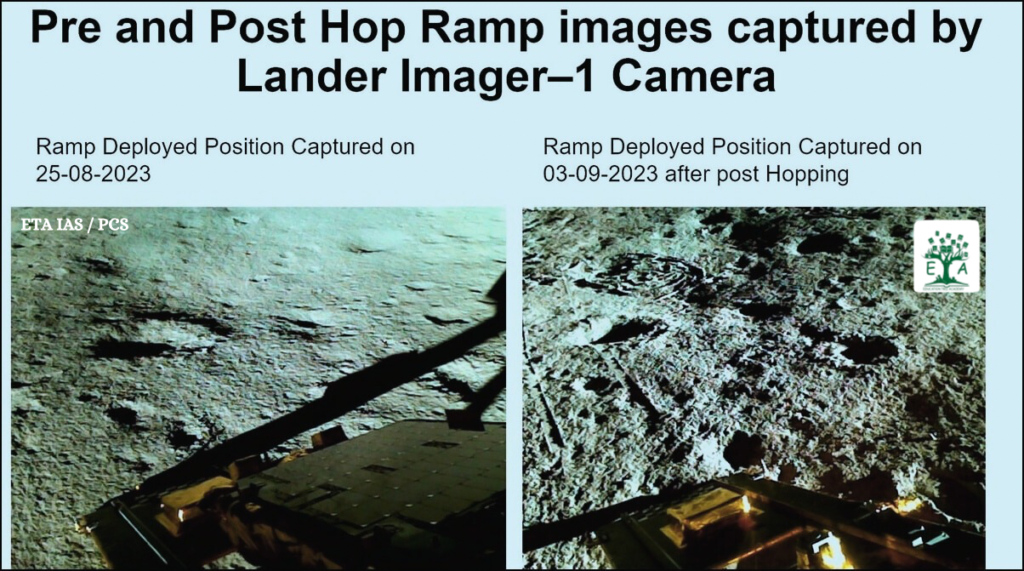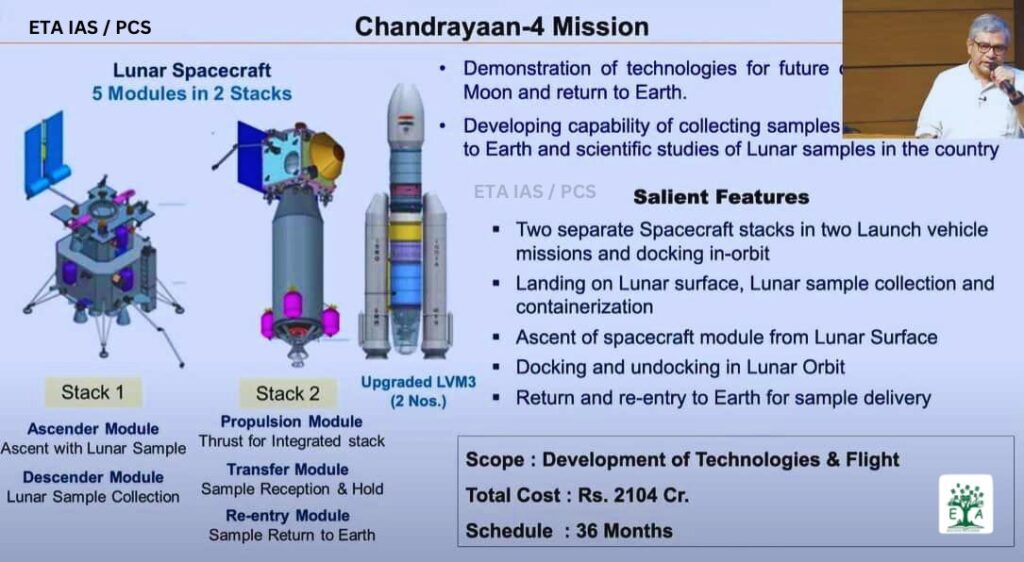Category
Date Posted
February 19, 2025
/
The Chandrayaan -3 "Hop" Experiment
Chandrayaan-3 Hop Experiment:
- Lander Soft Landing: The Chandrayaan-3 lander, Vikram, successfully made a soft landing on the Moon in August 2023.
- Unused Propellant: After the soft landing, there was still some propellant left in Vikram.
- Lifting the Lander: ISRO decided to use the remaining propellant to lift the lander once more and move it nearby.
- Lander’s Hop: The engines of Vikram were reignited, lifting it to a height of 40 cm before it landed approximately 30-40 cm away from its original position.
- Unexpected Hop Experiment: This action resulted in an unintended but valuable hop experiment on the lunar surface.
Significance:
- Demonstrating Capability: ISRO showcased its ability to reignite the engines and produce enough thrust to lift the lander off the ground.
- Future Lunar Missions: This successful demonstration is crucial for future lunar missions, especially those involving return journeys to Earth.

About Chandrayaan-3 Mission:
- Launch: ISRO’s third lunar mission was launched in 2023.
- Launch Vehicle: The mission used the Launch Vehicle Mark-3 (LVM3).
- Mission Components: The mission consisted of an indigenous propulsion module, lander module (Vikram), and a rover (Pragyan).
- Vikram Lander Landing: The Vikram lander successfully touched down on the Moon on August 23, 2023, demonstrating ISRO’s full capability in safe landing and roving on the Moon’s surface.
- South Pole Approach: Chandrayaan-3 made one of the closest approaches to the Moon’s South Pole, landing about 600 kilometers from the South Pole, on the near side of the Moon.
- Pragyan Rover Operations: The Pragyan rover operated for one lunar day (approximately 14 Earth days), aimed to collect lunar samples, conduct in-situ experiments, and send data to the Vikram lander for transmission back to Earth.
- Virtual Launch Control Centre: The Vikram Sarabhai Space Centre’s Virtual Launch Control Centre played a key role in continuous real-time monitoring of the launch activities from SHAR.
- Landing Site Name: The International Astronomical Union approved the name “Statio Shiv Shakti” for the landing site of Vikram.
- Historical Achievement: India became the fourth country to land a spacecraft on the Moon (after the U.S., Russia, and China) and the first to achieve a soft landing near the lunar South Pole.
DO YOU KNOW ABOUT THE CHANDRAYAAN -4 MISSION ?
Chandrayaan-4 Mission:
- Mission Type: Chandrayaan-4 is a planned lunar sample return mission.
- Expected Launch: The mission is expected to launch around 2027.
- Initiative: The mission is an initiative of the Indian Space Research Organisation (ISRO).
- Part of Chandrayaan Series: It is the fourth iteration in ISRO’s Chandrayaan lunar series.
- Mission Aim: The primary goal is to collect samples from the Moon’s surface and return them to Earth.
- Landing Site: The landing site is planned to be near Statio Shiv Shakti, the landing site of Chandrayaan-3, located close to the lunar South Pole region.

Spacecraft Design and Mission:
- Design Overview: The spacecraft will consist of five modules launched across two separate missions using two Launch Vehicle Mark-3 (LVM-3) vehicles.
- First Launch: The Ascender Module (AM) and Descender Module (DM) will be launched together in the first mission.
- Second Launch: The Re-entry Module (RM), Transfer Module (TM), and Propulsion Module (PM) will be launched in the second mission.
- Docking: After the two launches, the modules will be docked together in an elliptical Earth orbit, forming an integrated stack.
2. Lunar Landing:
- Docking and Maneuvers: After docking, the Integrated Stack will perform the first set of Earth-bound maneuvers using the Propulsion Module (PM).
- Separation for Descent: In the final lunar orbit, the Descender Module (DM) and Ascender Module (AM) will separate from the Transfer Module (TM) and Re-entry Module (RM).
- Powered Descent: DM and AM will undergo a powered descent to achieve a soft landing on the Moon’s surface.
- Sample Collection: After landing, a robotic arm (Surface Sampling Robot) will scoop around 2-3 kg of samples from the lunar surface. A drilling mechanism will also collect sub-surface samples, which will be sealed for return to Earth.
3. Re-Entry into Earth’s Atmosphere:
- Ascension and Docking: After sample collection, the Ascender Module (AM) will ascend to lunar orbit and dock with the parked Transfer Module (TM) and Re-entry Module (RM).
- Sample Transfer: Samples will be transferred from AM to RM. Following the transfer, TM and RM will undock from AM.
- Earth Return Maneuvers: TM and RM will perform maneuvers to return to Earth. At a suitable entry corridor, RM will separate from TM and perform ballistic re-entry into Earth’s atmosphere.
- Landing: After re-entry, RM will land on Earth, carrying the lunar samples.
Challenges:
- Docking and Undocking: Demonstrating successful docking in Earth’s orbit and undocking in lunar orbit.
- Re-entry: Ensuring safe re-entry into Earth’s atmosphere while withstanding intense heat and pressure.
- Sample Preservation: Maintaining the lunar samples in an uncontaminated state during the return journey.
Significance:
- Critical Process Validation: The mission will validate key processes such as docking/undocking in lunar orbit, precise landing techniques, and safe return through Earth’s atmosphere.
- Contribution to Future Missions: Chandrayaan-4 will play a vital role in the development of systems needed for India’s planned crewed lunar landing in 2040.
UPSC PYQ 2016
Q. Consider the following statements:
The Mangalyaan launched by ISRO
1. is also called the Mars Orbiter Mission
2. made India the second country to have a spacecraft orbit the Mars after USA
3. made India the only country to be successful in making its spacecraft orbit the Mars in its very first attempt
Which of the statements given above is/are correct?
(a) 1 only
(b) 2 and 3 only
(c) 1 and 3 only
(d) 1, 2 and 3
Answer: (c)
EXPLANATION OF THE ABOVE ANSWER
Statement 1: “The Mangalyaan launched by ISRO is also called the Mars Orbiter Mission.”
- Correct. The Mars Orbiter Mission (MOM) is popularly known as Mangalyaan. This mission was launched by ISRO (Indian Space Research Organisation) in November 2013 with the aim to explore Mars.
Statement 2: “Mangalyaan made India the second country to have a spacecraft orbit the Mars after USA.”
- Incorrect. India became the fourth country to successfully send a spacecraft to Mars and get it into orbit. The first country was the USA (NASA’s Mariner missions and others), followed by Soviet Union (Mars program), and then European Space Agency (Mars Express). India was the first country to successfully do so on its first attempt, not the second.
Statement 3: “Mangalyaan made India the only country to be successful in making its spacecraft orbit the Mars in its very first attempt.”
- Correct. India is indeed the only country to successfully place a spacecraft in orbit around Mars on its first attempt. This is a major achievement, as many other countries, including the USA, Russia, and European Space Agency, had multiple attempts before successfully orbiting Mars.
Conclusion:
- Statement 1 is correct: Mangalyaan is also called Mars Orbiter Mission.
- Statement 2 is incorrect: India was the fourth country, not the second.
- Statement 3 is correct: India was the only country to succeed in the first attempt.
Thus, the correct answer is (c) 1 and 3 only.

Usefull content
Thank you sir